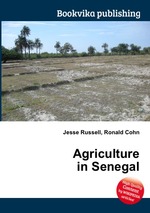Agriculture in Senegal
Jesse Russell Ronald Cohn
бумажная книга
High Quality Content by WIKIPEDIA articles! Most of Senegal lies within the drought-prone Sahel region, with irregular rainfall and generally poor soils. With only about 5 percent of the land irrigated, Senegal continues to rely on rain-fed agriculture, which occupies about 75 percent of the workforce. Despite a relatively wide variety of agricultural production, the majority of farmers produce for subsistence needs. Production is subject to drought and threats of pests such as locusts, birds, fruit flies, and white flies. Millet, rice, corn, and sorghum are the primary food crops grown in Senegal. Senegal is a net food importer, particularly for rice, which represents almost 75 percent of cereal imports. Peanuts, sugarcane, and cotton are important cash crops, and a wide variety of fruits and vegetables are grown for local and export markets. In 2006 gum arabic exports soared to $280 million, making it by far the leading agricultural export. Green beans, industrial tomato, cherry tomato, melon, and mango are Senegal`s main vegetable cash crops. The Casamance region, isolated from the rest of Senegal by Gambia, is an important agriculture producing area, but without the infrastructure or transportation links to improve its capacity.


